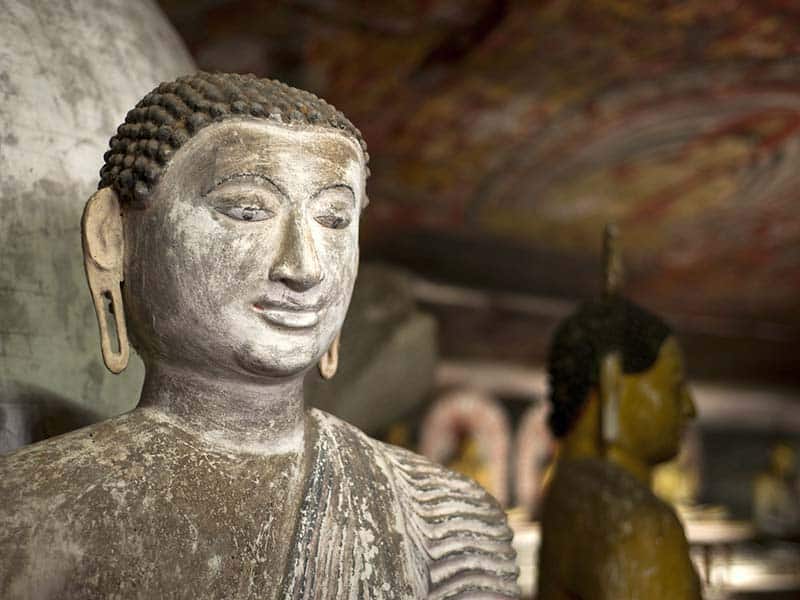A complex of five caves, lying ensconced within a 600-foot rock massif rising from the plains. The history of the Dambulla Cave Temple or Golden Temple of Dambulla dates back to the 1st Century BC. Dambulla Cave Temple complex was initially used as a refuge by King Vattagamini Abhaya during the siege of the capital Anuradhapura. Who later went on to establish the cave temple as a measure of gratitude for providing him shelter and security. Over the centuries, Kings after him tended and expanded the caves to the five individual caves that stand today. Within the caves, some of the finest examples of early Sinhalese art and sculpture can be found in its intricate frescoes and imposing statues of the Buddha. The Golden Temple is a World Heritage site. It gets its name from the dozens of gilded statues that adorn its interiors.
1st Cave
The first cave is the Devaraja Lena or Cave of The Lord of the Gods. This cave features a massive 45-foot statue of the sleeping Buddha in a Parinirvana state, said to be the moment of his final passing. A statue of one of his closest disciples, the Venerable Ananda stands at his feet watching over him. Another one of the Hindu deity Vishnu lies at the head. The walls of the cave are covered in murals. Although they have been repainted over the centuries, they show signs of degradation due to the smoke from the incense and oil lamps of pilgrims in early times.
2nd Cave
The Maharaja Lena or Cave of the Great Kings is the second cave. This cave is the largest being 125 feet in length, 75 feet in depth, and 21 feet at its highest point. In fact, this is the most impressive within the complex and holds over sixty images of the Buddha in different mudras. The life-size statue of a standing Buddha under a dragon arch is the focal point of this cave. Further, it displays parts of the gold gilt which it was covered in at its creation.
A stupa surrounded by eleven statues of the seated Buddha can also be found in this cave. Thereby highlighting the close association between the two religions and they are statues of the Hindu Gods Saman, Upulvan, Maithree, and Natha. The rock walls of the cave are adorned with murals detailing early Buddhist historical events. These murals are in a good state of preservation.
3rd Cave
The Maha Aluth Vihare, or Great New Temple is the third of the caves. This cave was created by King Kirti Sri Rajasinha who reigned in the middle of the 18th Century. Two immense doorways with dragon arches lead into this cave and within it lies a 30-foot statue of the reclining Buddha. At the center of the cave lies a statue of the seated Buddha under a dragon arch. Furthermore, it is surrounded by 42 images of the standing Buddha and 15 seated Buddhas. These magnificent murals on the walls depict the typical Kandyan style in this cave.
4th Cave
The fourth cave of the Dambulla Cave Temple, the Paccima Viharaya, or the Western Temple. This cave features an ornate image of the seated Buddha under a dragon arch. There are numerous identical images of the seated Buddha in meditative posture lining its walls. A small dagoba, once covered in murals, shows signs of vandalism by treasure hunters. They may have believed it held the jewelry of King Vattagamini’s wife, Somawathi. The Devini Aluth Vihare, or Second New Temple is the most modern. In contrast, its images are built of brick and plaster whereas the rest are all hewn from rock. Its age notwithstanding, it presents a unique atmosphere and features a 32-foot reclining Buddha, and eleven smaller images in the standing and seated positions, two of which depict a hooded cobra above the statue
Written by Jonathan Roelofsz for Travel Lanka Compass



0 Comment